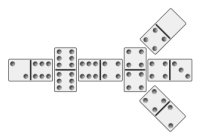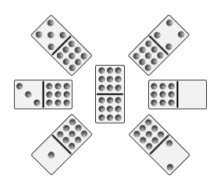Chickenfoot Domino Rules
How To Play Chickenfoot Dominoes

Chickenfoot Dominoes, sometimes called "Chickie Dominos", is a fascinating domino game which was inspired by Betty and Louis Howsley. The object of the game is to play all your tiles and have the lowest score at the end of the game. Your score is counted by the number of dots on the tiles remaining in your hand. Chickenfoot is played in rounds, one round for each double domino in the set.
Setup
For double-six dominoes, there are seven rounds. The score keeper writes 0 through 6 on the top of the score sheet and creates a score column for each player. All dominos are face down in the center. Each player picks 5 dominos at random to make their hand.
The First Round
The player with the double-6 plays it in the center of the play field. If no player has the double-6 then the player with the next highest double plays it. The player to left of the first player plays any domino in their hand with a 6 on it on one of the four sides of the initial tile with the 6 against a free side of the double-6. The next player plays another 6 on a remaining side until all four sides are filled. If a player cannot play because they do not have a 6, then the player draws one domino from the bone yard and either plays it because it has a 6 or calls "Pass". No other plays can be made until all four sides of the double are filled. Once all four sides are filled, the player to the left of the last person to fill the 6 may play any domino in their hand that matches an exposed end of a played domino. If a player is unable to match any exposed dominos, they must draw one domino from the bone pile and either play it if possible or call "Pass". If no dominos remain to draw from, the player simply calls "Pass".

The Chickenfoot
Any time a player plays a double of any number on the exposed domino with the same number as the double, the player calls "Chickie (Number)". For example, if a player played a double-4 on the end of a the 6-4 domino they would lay it long side against the end with the 4 and call "Chickie Fours". No other dominos can be played until three more 4's are played against the double 4. The three dominos played against the double-4 are played on the long side opposite the side originally played. The end result will look like a chicken foot with the double-4 having one domino laid perpendicular to one side, and three more dominos on the opposite side, the middle being perpendicular and the other two at 45 degrees to perpendicular. Any player who does not have a 4 must draw a domino from the bone pile and either play it if it has a 4 or call "Pass". Once all three 4's are played, the next player may play any domino in their hand on any exposed end that matches. Play continues until a player is out of dominos or no player can make a legal play.
Ending A Round
A round is over when either one player plays the last domino in their hand or no players can make a legal play. This situation can occur if someone chickie's a number that no longer has three remaining free dominos to play on it.
At the end of a round, each player adds the spots on the dominos in their hand and adds this to their score. The score keeper crosses out the double that lead the round and the next round begins with the highest double left. When all 7 rounds are played, the player with the lowest score wins.
Strategy
Since the object of the game is to have the lowest score, it is in your best interest to get rid of your high value dominos and at the same time, prevent your opponents from playing theirs. To this end, one strategy is to try to keep high value exposed ends covered which prevents opponents from chickie-ing them. Another strategy is to horde low value dominos and try to use up a particular number which you have the double for. Once you know that there are no longer three free dominos to complete the chickie, you control when the round ends by playing the chickie. This is especially good when you also have that number as your last domino. It also pays to keep the double blank since it adds no value to your score. Like poker, watching for looks of desperation on your opponents faces can clue you in to who has the big doubles.

More Dominos
With bigger domino sets, it is possible to have more players. A double-nines set is good for 4 to 6 players and each player would start with 7 dominos in their hand. A double-twelves set is good for up to 10 players, each with 7 dominos. If you have fewer players and more dominos, start with more dominos in each players hand, but leave enough dominos in the bone pile to draw from. When using double-twelves, make sure you have plenty of playing room as it can spread out considerably.
With larger domino sets, a round starts with a double chickenfoot, where three tiles connect to each long edge of the starting double - two at right angles, and four at the diagonals. You may purchase a special Chickenfoot hub to make placement of these initial tiles easier.
Number Of Rounds
Double-6s = 7 rounds, double-9s = 10 rounds, double-12s = 13 rounds. When all rounds are played, the player with the lowest score wins the game.
Click here for a Chickenfoot scoring sheet that you can print out and use when playing the game. The scoresheet is in PDF format.
Other Sources of Chickenfoot Domino Rules
- See Also:
- Purchase Chickenfoot Dominoes
Note: The Chickenfoot image at the top of the page is provided courtesy of Puremco, one of the world's largest manufacturers of domino games. Article text based on the Wikipedia, licensed under the GFDL.

 Dominoes Info
Dominoes Info